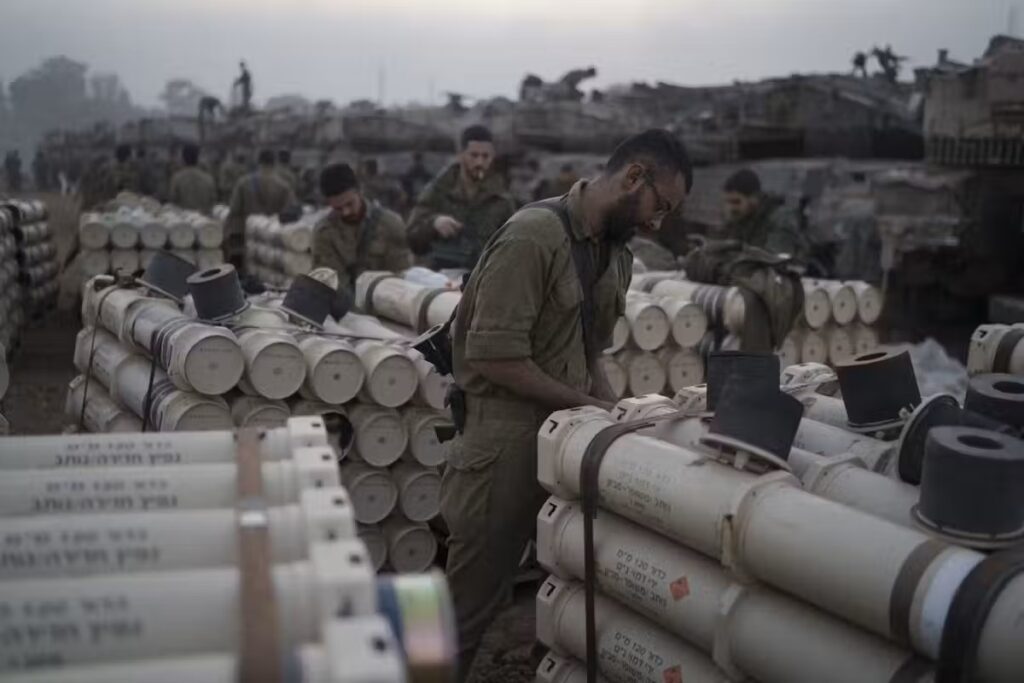Where Do Israel & Hamas Get Their Weapons?
Jan 24, 2024 | Pratirodh Bureau
Israeli troops store tank shells near the Israel-Gaza border (AP Photo/Leo Correa)
The fighting continues between the Israel and Hamas in and around Gaza. The death tolls continue to rise, but where do the weapons keep coming from?
Since Oct. 7, 2023, both sides have fired missiles and rockets, mortars and other weapons at each other. Israeli missiles and bombs have killed over 25,000 people in Gaza, according to the United Nations. Hamas has launched over 13,000 rockets and mortar rounds into Israel and killed 189 Israel Defense Forces soldiers.
As a scholar of the global defense industry and international weapons trade, I see that both Israel and Hamas make some of their own weapons and get the rest from suppliers in other nations.
Israel’s Weapons Supply
For a small country, Israel has a highly regarded defense industry, which can ramp up production on short notice in case of increased fighting. Three Israeli companies rank among the world’s top 100 arms producers: Elbit Systems manufactures ammunition and artillery; Israel Aerospace Industries produces unmanned aerial vehicles; and Rafael makes air defense systems. Rafael and Israel Aerospace Industries collaborated to develop the highly regarded Iron Dome missile defense system. The U.S. provided development aid, and about half of Iron Dome’s components are made in America.
Led by those firms, Israel has gone from being a net weapons importer to the world’s 10th-largest arms exporter. Much of its success in the weapons industry is a result of entrepreneurship and innovation within the overall economy, as well as civilian-military linkages.
Israel also imports weapons from other countries. According to the Stockholm International Peace Research Institute’s arms transfers database, 68% of Israel’s weapons imports from 2013 to 2022 came from the U.S. Another 28% came from Germany. Imports are funded in part by $3.3 billion of military aid provided annually by the U.S., along with $500 million for missile defense cooperation.
Since the start of the Israel-Hamas war, the U.S. has provided more than 5,000 MK-84 munitions, a type of 2,000-pound bomb. As of late December 2023, the U.S. had sent artillery shells, armored vehicles and basic combat tools to Israel, delivered in 230 cargo planes and 20 ships.
U.S. military aid to Israel also includes stockpiled weapons. For years, the Pentagon has stored weapons in Israel, presumably for use by the U.S. military. But the U.S. has allowed Israel to draw down some of these supplies during the Gaza conflict.
In fact, the U.S. has directed some of these stored armaments to be sent to Ukraine, which allows those warehouses in Israel to be restocked with more advanced equipment. Less sophisticated bombs and bullets shipped to Ukraine will free up space, to be filled with precision-guided munitions from the U.S.
Hamas’ Weapons Supply
In response to Israeli blockades, Hamas has constructed an elaborate and extensive tunnel complex under Gaza and across the Egyptian border. Hamas gets most of its weapons from Iran. The weapons are transported though Egypt and smuggled into Gaza through the tunnels.
But Hamas’ weapons also include AK-47 assault rifles from China and Russia, and rocket-propelled grenades manufactured in North Korea and Bulgaria.
In the murky global arms trade, it can be difficult to determine who is selling weapons to whom. A weapon manufactured in one country could end up in the hands of Hamas by way of one or more intermediary countries. Like nonmilitary goods, copycat armaments also are part of the weapons business. Hamas fighters are using a variety of Soviet-era weapon designs that have been copied and manufactured by China and Iran.
Hamas even manufactures some arms in Gaza. Local factories, some of which are within the underground tunnels, produce mortars, rockets, rifles and bullets.
Some countries, such as Russia, give Hamas permission to imitate their products. Iran trains Gaza-based engineers on design and production techniques. Ironically, when the Israeli military destroys buildings and equipment in Gaza, material from the ruins is recycled by Hamas factories into weapons.
As the war progresses, Israel will likely be in a position to restock its depleted weapons, so long as Washington continues to provide political and military support. But with Israel now occupying much of Gaza, it will be far more difficult for Hamas to reload.
(Published under Creative Commons from The Conversation. Read the original article here)
